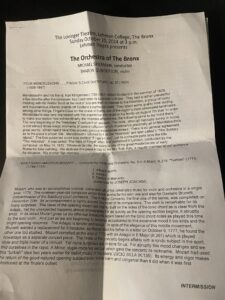By Anes Kolenovic

Beethoven’s Symphony No. 8 in F Major, Op. 93, performed live, is a captivating journey into the composer’s wit and mastery. Often overshadowed by the glory of his Seventh and Ninth symphonies, this “little Symphony in F” stands out with its compact structure and cheerful tone. The Bronx Symphony performance on Oct. 20th at Lehman College brought Beethoven’s humor and rhythmic innovation to life, creating an experience that was both engaging and enlightening.
The concert venue played an integral role in shaping the atmosphere of the performance. The Lovinger Hall was decently sized, offering a special setting that allowed the nuances of the music to shine through (almost blinded). It was well attended and with an enthusiastic audience that seemed to share in the performers’ energy. The setting was formal yet inviting, striking a balance that made the performance feel both accessible and sophisticated.
Beethoven’s Symphony No. 8 was the highlight of the program, though other pieces contributed to a cohesive musical experience. The symphony, composed in 1812, is a testament to Beethoven’s ability to balance structure with expression (Kinderman, Beethoven, 2009) I can’t believe Beethoven was almost deaf by this point ins life. . The second movement, famously inspired by the invention of the metronome, evoked laughter from the audience as the ensemble performed its rhythmic quirks with precision. The finale, brimming with surprises and dynamic contrasts, showcased the orchestra’s skill in capturing Beethoven’s spirited character. Comparing live performances with recordings, such as those by the Berlin Philharmonic under Herbert von Karajan (Deutsche Grammophon, 1962), reveals how much the energy of a live audience enhances the humor and vitality of the work.
The performers demonstrated remarkable skill and a deep understanding of Beethoven’s style. The conductor, Michael Spierman, whose gestures seemed to draw out the best in the musicians, created a sense of unity within the ensemble. (Now we just need to do that with our senate). Solo passages stood out for their clarity and expressiveness, and the orchestra maintained a lively play throughout the performance. The players attire was formal yet not overly pretentious, aligning with the tone of the event. Between pieces, brief remarks from the conductor offered insights into the program, deepening the audience’s appreciation.
I want to dedicate a part of this essay to what really struck me as a first time classical music experience. It was an absolutely inviting environment despite the age gap I felt in the audience (a lotta older people 🙂). Micheal Spierman was an amazing conductor from what I could tell and definitely has the experience to back it up. I could see the emotion and dedication with each strike of his Magical Music Stick™ (A baton). I also enjoyed how beautifully Sharon Gunderson played with her violin, almost looking like she doesn’t belong with her flashy blue hair. It was awe inspiring seeing her story and how she performed for recovery workers at ground zero. All in all, they both along with all the other performers (Including you 👏) played beautifully.
Overall, this concert was a delightful celebration of Beethoven’s genius and the performer’s talent. It’s weird to see such a thing in The Bronx as I see The Bronx as dirty and barbaric, but this is like a full 180 from that. The playful nature of Symphony No. 8, combined with the ensemble’s engaging presentation, left a lasting impression. I would fully recommend this performance to friends and look forward to attending future events by this ensemble. Experiencing Beethoven’s work in such a vivid and intimate setting reaffirmed why his music continues to resonate so powerfully today.
Works Cited
Kinderman, William. Beethoven. Oxford University Press, 2009.
Steinberg, Michael. The Symphony: A Listener’s Guide. Oxford University Press, 1995.
Berlin Philharmonic, conducted by Herbert von Karajan. Beethoven: The Symphonies [Complete]. Deutsche Grammophon, 1962.
